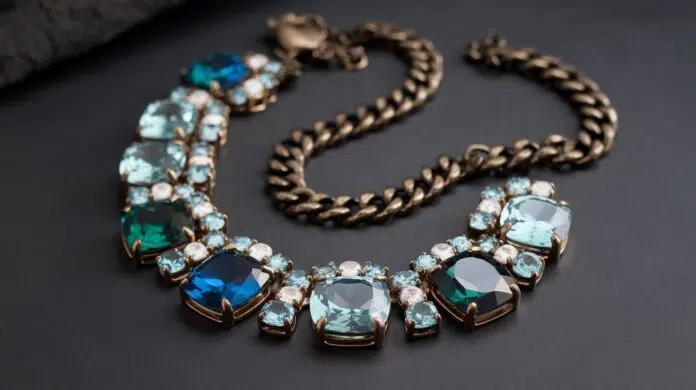Gemstone necklaces are a timeless accessory, capable of transforming any outfit with their natural beauty and elegance. Whether you’re drawn to bold statement pieces or prefer subtle, minimalist designs, selecting the right gemstone necklace to complement your personal style can feel daunting. In this guide, we’ll walk you through the essential factors to consider to make the perfect choice.
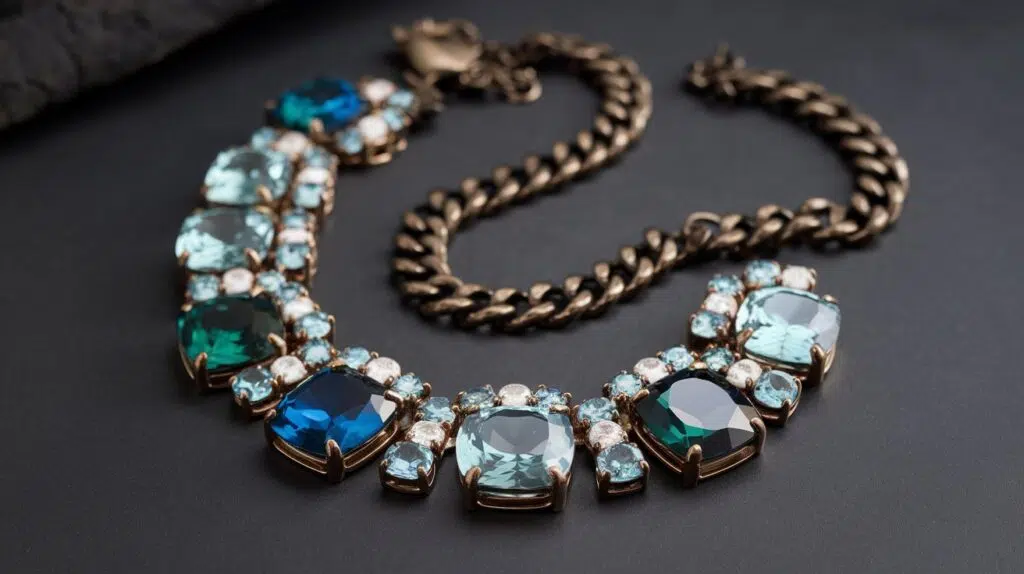
1. Understand Your Personal Style
Your wardrobe and preferred aesthetics play a significant role in determining the type of gemstone necklace that will suit you best. Ask yourself these questions:
- Do you lean toward classic, modern, bohemian, or eclectic styles?
- Are your outfits typically neutral, vibrant, or patterned?
- Do you prefer gold, silver, or rose gold settings for your jewelry?
Style Tips:
- Classic Style: Opt for timeless stones like diamonds, pearls, or sapphires in simple, elegant settings.
- Modern Style: Go for sleek designs featuring geometric shapes and stones like onyx, quartz, or labradorite.
- Bohemian Style: Embrace colorful gemstones like turquoise, amethyst, or citrine in organic, free-form settings.
2. Choose the Right Gemstone
Gemstones carry unique meanings and symbolism. Selecting one that resonates with you adds a personal touch to your necklace.
Popular Gemstones and Their Meanings:
- Diamond: Timeless elegance and strength.
- Amethyst: Calmness and spiritual growth.
- Emerald: Love, renewal, and prosperity.
- Ruby: Passion and vitality.
- Sapphire: Wisdom and loyalty.
- Turquoise: Protection and positive energy.
Consider also incorporating your birthstone for a deeper connection to your jewelry.
3. Match the Necklace to the Occasion
Gemstone necklaces can range from casual to formal, and the occasion often dictates the design.
- Everyday Wear: Select small, durable gemstones like garnet or peridot in simple settings.
- Workplace: Stick to understated designs with neutral tones such as black onyx or aquamarine.
- Formal Events: Choose larger, eye-catching gemstones like opal, ruby, or diamond in intricate designs.
4. Pick a Necklace Length That Suits You
The length of your necklace impacts how it complements your neckline and overall look.
- Choker (14-16 inches): Best for open necklines, adding a dramatic flair.
- Princess (18 inches): A versatile option that works with most outfits.
- Matinee (20-24 inches): Great for layering and pairing with business or casual wear.
- Opera (28-36 inches): Ideal for high necklines and elegant evening looks.
5. Consider Skin Tone When Choosing Metal and Gemstone Colors
The color of your gemstone and its metal setting should harmonize with your skin tone:
- Cool Skin Tones: Favor white gold, platinum, or silver settings with gemstones in blue, green, or purple hues like sapphire, emerald, or amethyst.
- Warm Skin Tones: Opt for yellow gold or rose gold with gemstones in red, orange, or yellow tones like ruby, citrine, or garnet.
- Neutral Skin Tones: You can mix and match metals and gemstone colors with ease.
6. Set a Budget
Gemstone necklaces come in a wide range of prices, influenced by the type, size, and quality of the stone as well as the craftsmanship. Before shopping, determine your budget to narrow down your options. Remember, lab-created gemstones can offer stunning beauty at a fraction of the price of natural stones while maintaining durability and quality.
7. Explore Customization Options
For a truly unique piece, consider customizing your necklace. Many jewelers offer bespoke services where you can choose the gemstone, setting, metal, and design. Customized necklaces make for meaningful gifts or personal treasures.
8. Shop From Reputable Sources
When buying gemstone necklaces, ensure you purchase from reputable sellers to guarantee authenticity. Look for certifications like GIA (Gemological Institute of America) to verify the quality of your gemstones.
Best Birthstone Necklace for Every Month
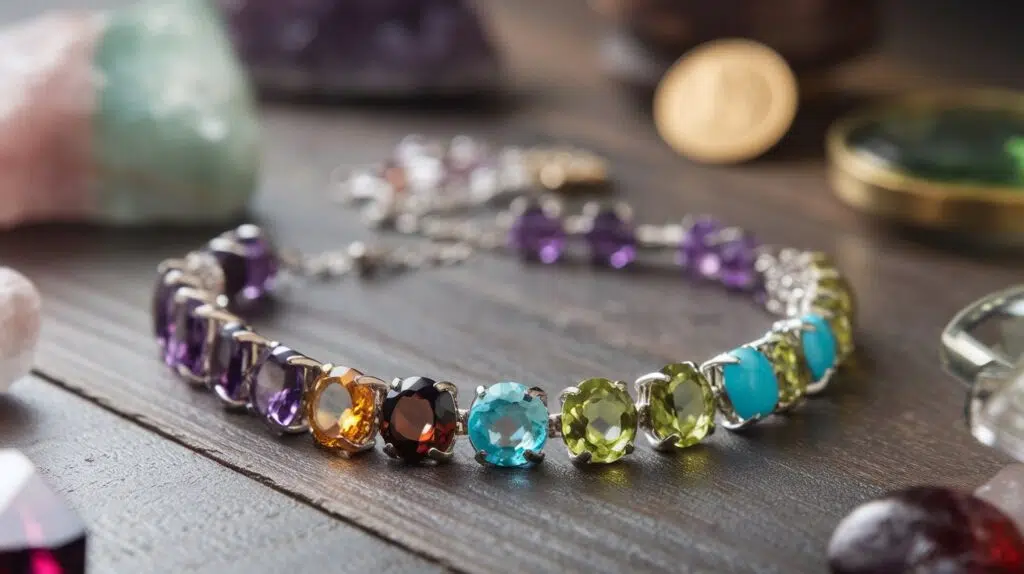
Birthstone necklaces are a meaningful and stylish way to celebrate your birth month or the special people in your life. Whether you’re shopping for yourself or searching for a thoughtful gift, a birthstone necklace is a timeless choice. Here, we explore the best birthstone options for each month and provide tips on how to choose the perfect one.
January: Garnet
Symbolizing protection and strength, garnet is a deep red gemstone that’s perfect for elegant, bold styles. Look for garnet necklaces in silver or gold settings to enhance its rich color.
February: Amethyst
Known for its calming and spiritual properties, amethyst comes in striking purple hues. Amethyst necklaces are versatile, adding a pop of color to both casual and formal outfits.
March: Aquamarine
This pale blue gemstone represents tranquility and clarity. Aquamarine necklaces are often paired with white gold or platinum to highlight their serene beauty.
April: Diamond
Diamonds symbolize eternal love and strength, making them an iconic choice. For April birthdays, a simple diamond pendant offers timeless elegance that never goes out of style.
May: Emerald
Emeralds, with their vibrant green color, symbolize renewal and growth. Emerald necklaces in yellow gold settings bring out the gemstone’s lush beauty.
June: Pearl or Alexandrite
June babies can choose between classic pearls, symbolizing purity, or rare alexandrite, known for its color-changing properties. A pearl strand necklace or an alexandrite pendant adds sophistication to any look.
July: Ruby
Representing passion and vitality, rubies are fiery red gemstones that make a bold statement. Ruby necklaces in rose gold settings offer a contemporary twist to this timeless gem.
August: Peridot
Peridot’s lime-green hue symbolizes prosperity and warmth. Choose peridot necklaces with minimalistic designs for an effortlessly chic look.
September: Sapphire
Sapphires, known for their deep blue tones, symbolize wisdom and loyalty. A sapphire pendant set in silver or platinum makes for an eye-catching accessory.
October: Opal or Tourmaline
October offers two stunning options: opal, with its iridescent glow, or tourmaline, available in a variety of colors. Both make unique and beautiful necklaces.
November: Citrine or Topaz
Citrine’s warm yellow tones and topaz’s variety of hues symbolize abundance and joy. A citrine necklace in gold is perfect for adding brightness to your collection.
December: Turquoise, Tanzanite, or Zircon
December birthdays are spoiled for choice with three gemstones. Turquoise offers a bohemian vibe, tanzanite dazzles with deep blue-violet hues, and zircon provides brilliance comparable to diamonds.
How to Choose the Perfect Birthstone Necklace
- Consider Personal Style: Select a design that matches the recipient’s fashion preferences.
- Choose the Right Setting: Metals like gold, silver, and platinum enhance the beauty of different gemstones.
- Think About Symbolism: Add a personal touch by choosing a birthstone with special meaning.
Luxury vs. Affordable Gemstone Necklaces: Which Should You Choose?
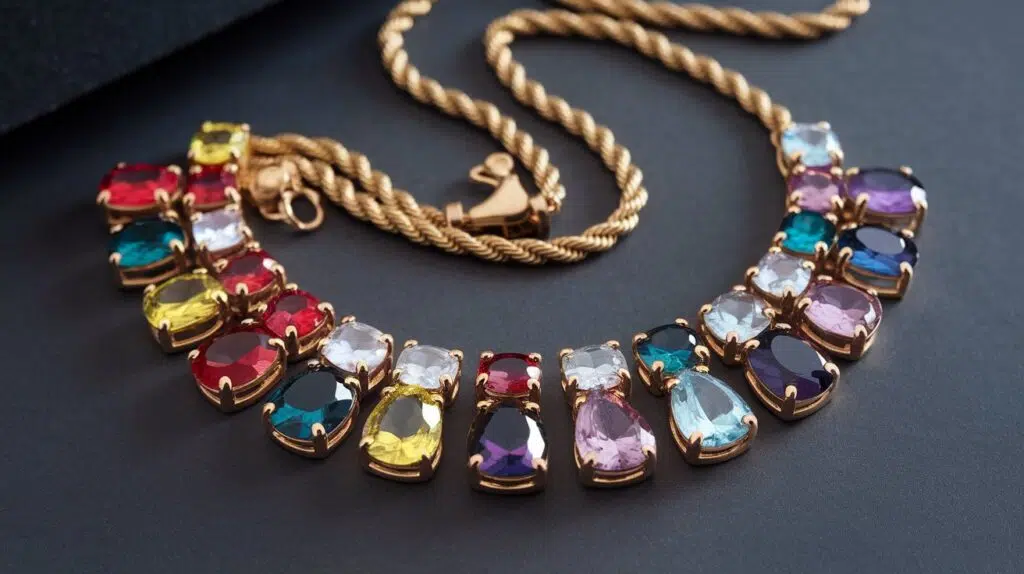
When it comes to gemstone necklaces, the choice between luxury and affordable options often comes down to personal preference, budget, and intended use. Each category offers unique benefits, and understanding their differences can help you make the best decision. Here, we explore the key factors to consider when choosing between luxury and affordable gemstone necklaces.
The Appeal of Luxury Gemstone Necklaces
Luxury gemstone necklaces are synonymous with exceptional craftsmanship, high-quality materials, and exclusivity. They often feature rare gemstones, intricate designs, and premium metals like platinum or 18K gold. Here’s why you might opt for a luxury piece:
- Timeless Elegance: Luxury necklaces often boast classic designs that never go out of style, making them heirloom-worthy.
- Investment Value: High-quality gemstones and precious metals tend to retain or even increase in value over time.
- Unique Features: Many luxury pieces are handcrafted or customized, ensuring a one-of-a-kind accessory.
However, luxury necklaces come with a significant price tag, which may not fit every budget. They’re ideal for special occasions, gifts, or collectors looking for long-term value.
The Advantages of Affordable Gemstone Necklaces
Affordable gemstone necklaces are perfect for those seeking beauty and versatility without breaking the bank. These pieces often use lab-created or semi-precious stones paired with silver or gold-plated metals. Key benefits include:
- Budget-Friendly: You can enjoy stylish designs without a hefty price tag.
- Wide Variety: Affordable options often feature trendy styles and a diverse range of gemstones, ideal for everyday wear.
- Low Risk: These necklaces are great for travel or casual use, where high-value items might pose a risk.
While affordable options may lack the longevity or rarity of luxury pieces, they allow you to experiment with different styles and colors without a major financial commitment.
How to Decide: Luxury or Affordable?
Your decision should be guided by your lifestyle, needs, and preferences. Consider the following:
- Occasion: For formal events or milestones, a luxury necklace may elevate your outfit. For daily wear, affordable options offer practical elegance.
- Budget: Luxury necklaces are an investment, while affordable ones provide immediate gratification at a lower cost.
- Personal Style: If you value exclusivity and craftsmanship, luxury is the way to go. If you enjoy experimenting with trends, affordable options are more adaptable.
How to Spot Real vs. Fake Gemstone Necklaces?
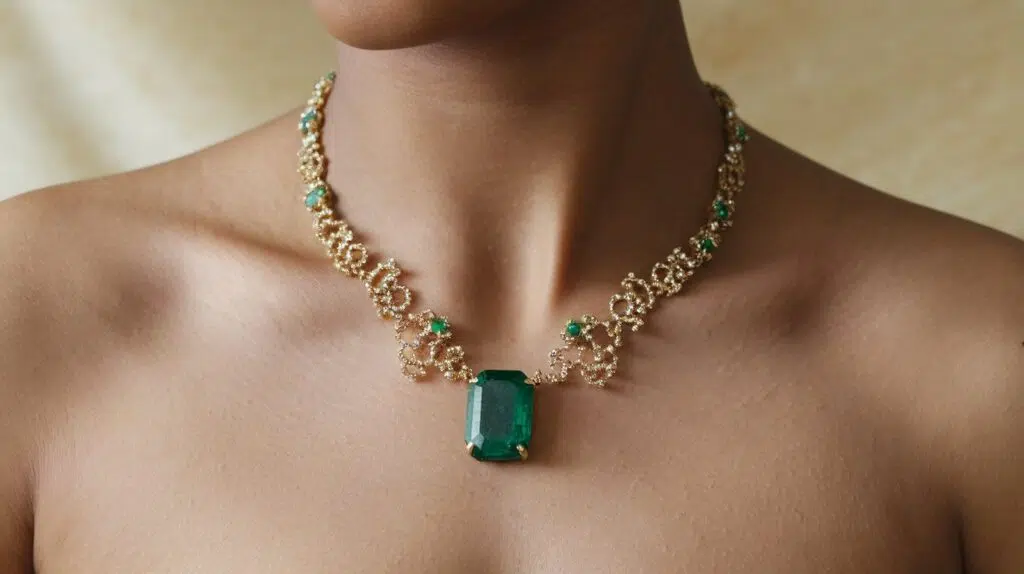
Gemstone necklaces are captivating accessories that add elegance and charm to any look. However, distinguishing between real and fake gemstones can be tricky, especially with advancements in synthetic and imitation materials. If you’re looking to invest in a genuine piece, here are essential tips to help you identify real gemstone necklaces.
1. Check the Color and Clarity
Natural gemstones often have subtle imperfections, such as inclusions or slight variations in color. These imperfections add character and authenticity. On the other hand, fake or synthetic gemstones tend to look too perfect, with flawless clarity and uniform color.
Tip:
- Compare the gemstone with authentic examples online or in stores to familiarize yourself with natural variations.
2. Test the Weight
Genuine gemstones are denser and heavier than their fake counterparts. Hold the necklace and feel its weight. If the gemstones feel unusually light, they may be made of glass or plastic.
Tip:
- Compare the weight of the necklace with a similar genuine piece if possible.
3. Inspect the Cut and Finish
Real gemstones are often cut with precision to enhance their natural beauty, but they may still have minor imperfections. Fake gemstones, particularly glass imitations, might have overly smooth surfaces or lack the intricate facets of genuine stones.
Tip:
- Use a magnifying glass to examine the gemstone’s surface and cuts.
4. Conduct a Fog Test
Natural gemstones and genuine metals do not retain heat for long. To test, breathe on the gemstone as you would a mirror. A real gemstone will clear up almost instantly, while a fake one may stay fogged for a few seconds.
Tip:
- Perform this test in combination with other methods for better accuracy.
5. Look for Certification
Reputable jewelers often provide certification for their gemstone necklaces, verifying the type, quality, and authenticity of the stones. Look for certificates from trusted organizations like the Gemological Institute of America (GIA) or the International Gemological Institute (IGI).
Tip:
- Always request a certificate when purchasing high-value gemstone jewelry.
6. Examine the Setting and Metal
The quality of the necklace setting can also provide clues. Genuine gemstones are usually set in high-quality metals such as gold, platinum, or sterling silver. If the necklace features cheap or poorly finished metals, it might be a sign of fake gemstones.
Tip:
- Check for stamps indicating the metal’s purity, such as “925” for sterling silver or “14K” for gold.
7. Consult a Professional
When in doubt, take the necklace to a certified jeweler or gemologist. Professionals have the tools and expertise to identify real gemstones accurately.
Tip:
- Many jewelers offer gemstone appraisal services at a reasonable cost.
Conclusion
Knowing how to spot real vs. fake gemstone necklaces ensures you make informed purchases and get value for your money. By checking for natural imperfections, testing weight, and seeking certifications, you can confidently identify genuine pieces. Explore our recommended collections to find certified gemstone necklaces that meet your style and budget.


